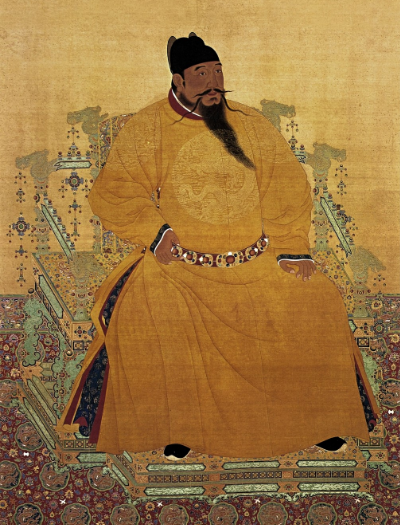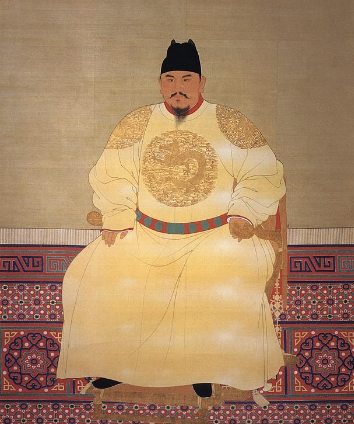Ming emperors wore dragon robes, mandarin squares, imperial hats, and boots, symbolizing their supreme status.
Dragon Robe (龙袍)
Design Features
The Dragon Robe, an emblem of imperial dignity, showcases distinct design features. Central to its design are the dragons, often five-clawed, representing the emperor’s supreme power. These dragons, embroidered or woven, appear to be chasing or grasping for the mystical pearl. The background fabric typically features patterns of clouds, waves, mountains, and other nature-inspired motifs. The color choice, predominantly yellow or gold for emperors, signifies the emperor’s exclusive status. The robe combines both aesthetic appeal and symbolic depth, making it a masterpiece of imperial fashion.

| Feature | Dragon Robe | Ordinary Robe |
|---|---|---|
| Dragons | Five-clawed, symbolizing imperial power | Less intricate or absent |
| Color | Predominantly yellow or gold, exclusive to emperors | Varied, without specific restriction |
| Patterns | Clouds, waves, mountains, symbolizing the universe | Simpler, less symbolic patterns |
| Symbolism | Represents emperor’s authority and divine right | Lacks significant imperial symbolism |
For more information, explore the Wikipedia page on Dragon Robes.
Ceremonial Use
In ceremonial settings, the Dragon Robe serves as more than mere attire; it embodies the emperor’s authority and divine mandate. During significant events like coronations, New Year celebrations, and important court gatherings, this robe is the centerpiece of imperial wardrobe. Its grandeur complements the solemnity of these occasions, visually reinforcing the emperor’s exalted position.
| Aspect | Dragon Robe in Ceremonies | Regular Attire in Ceremonies |
|---|---|---|
| Significance | Symbolizes the emperor’s divine authority | Lacks imperial significance |
| Occasions | Worn during coronations, important rituals | Not appropriate for high-profile ceremonies |
| Visual Impact | Enhances the ceremony’s grandeur | Less impactful and authoritative |
Mandarin Square (补子)
Symbolism
Mandarin Squares, or 补子, stand as a testament to the rich symbolism deeply ingrained in Chinese imperial culture. Central to each square is an animal or mythical creature, intricately embroidered, representing the wearer’s rank in the imperial hierarchy. For example, a crane, often depicted amidst clouds, symbolizes a civil official of the highest rank. This bird, revered for its grace and longevity, aligns perfectly with the virtues expected of top-ranking civil servants. Similarly, other animals like the golden pheasant for second-rank officials or the tiger for military officials, each carry unique symbolic meanings. These creatures are not only aesthetically pleasing but also convey messages about the wearer’s power, position, and responsibilities.
Variations
The design and complexity of Mandarin Squares change drastically across different ranks and occasions. High-ranking officials wear squares with more elaborate designs, using brighter colors and finer silk, signifying their elevated status. The distinction between civil and military officials is also prominently displayed in their respective squares: civil officials’ squares feature birds, signifying scholarly attributes, while military squares depict beasts, symbolizing bravery and strength.
In formal settings, these squares are more ornate, often embellished with additional motifs like sun, moon, or waves, adding layers of meaning and grandeur. Conversely, everyday versions are simpler, focusing more on functionality while still maintaining the dignity of the office.
Each Mandarin Square, therefore, is not just a piece of clothing but a complex symbol of identity, status, and societal order in the Ming Dynasty. Through these intricate badges, one can glimpse the profound cultural and social structures that defined imperial China.
Imperial Hat (冠帽)
Types and Styles
The Imperial Hat, known as 冠帽 in Chinese, showcases a variety of styles, each reflecting different aspects of the emperor’s power and status. The most renowned is the ‘Mianliu’, a formal hat adorned with strings of beads that veil the face, symbolizing the emperor’s elevated stature. Another notable style is the ‘Putou’, a simpler, black hat used for everyday wear, indicating the emperor’s role as the nation’s administrator. Each style, from the grand ‘Mianliu’ to the understated ‘Putou’, serves a specific purpose, reflecting the multifaceted nature of imperial duties.
Ritual Significance
In ritual contexts, the Imperial Hat takes on profound significance. During religious ceremonies and important state rituals, the emperor wears specific hats to signify his role as the intermediary between heaven and earth. For instance, the ‘Diadem’, adorned with symbolic ornaments like the pearl and jade, is often worn during sacrificial rites, highlighting the emperor’s role in maintaining cosmic harmony. The choice of hat for each ritual is not arbitrary; it is a deliberate decision that reinforces the emperor’s divine mandate and his solemn duties to the heavens and his people.

Imperial Boots (皇帝靴)
Design and Material
- Luxurious Fabrics: Artisans craft Imperial Boots from the finest silk and brocade, reflecting the emperor’s wealth and status.
- Embroidery and Embellishments: They skillfully embroider dragon motifs with gold and silver threads, symbolizing imperial power and adding opulence.
- Comfort and Durability: The soles combine durability with flexibility, ensuring both visual appeal and practicality.
- Attention to Detail: Meticulous design in every stitch and embellishment highlights the emperor’s exalted position.
Usage in Different Settings
- Formal Ceremonies: The emperor wears boots with intricate designs and heavy embroidery for grand ceremonies, aligning with the event’s solemnity.
- Everyday Administrative Tasks: For daily activities, the emperor chooses simpler yet elegant boots, balancing comfort and imperial dignity.
- Symbolic Representation: The emperor’s choice of boots for various occasions symbolizes his ability to adapt to different roles, from divine ruler to pragmatic administrator.